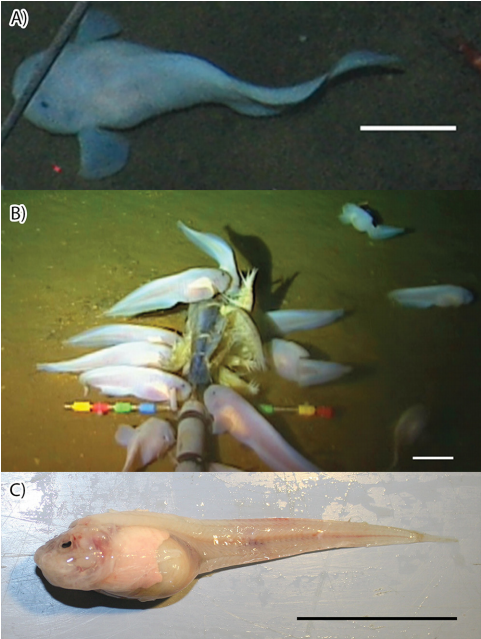
I learned this today. Deep sea fish can survive because they don’t breathe in the same way that we do. However, even they cannot survive at the very bottom of the ocean.
Pressure at sea level is 14.7 psi (pounds per square inch). If someone weighing 14.7 pounds stood on you, you would feel it, but we have evolved not to feel the air pressure because our internal organs and the fluids within us push back with the same amount of force. This 14.7 psi is known as 1 atmosphere. For every 10m you go down into the ocean, the pressure increases by 1 atmosphere. The deepest point in the ocean is the Challenger Deep in the Mariana trench and it is 10,935m, which is about 1,100 atmospheres. That means, the pressure at the bottom of the ocean is one thousand times greater than it is on the surface.
What would happen to a human at that depth? The deepest a human has ever scuba dived in the ocean is 332 m. Ahmed Gabr pulled off this amazing feat in 2014. The pressure on him would have been 33 atmospheres, or 33 times the pressure on the surface. The deepest free dive was 253 m by Herbert Nitsch in 2012. The pressure on him would have been 25 times that of the surface.
As divers descend into the ocean, the increase in pressure reduces the volume of gas in their body. Something is a gas when the atoms within it have a lot of energy and can move around freely. The atoms have a lot of space between them and the increase in pressure squashes the atoms closer and closer to each other. At 30m depth, the lungs will have contracted to 25% of their normal size. Any deeper, without proper training, and blood can flow into the lungs to equalize the pressure, causing severe damage. If the human were to carry on descending, their lungs would collapse and they would die.
So, how do fish and other creatures survive at the bottom of the ocean?
The deepest layer of the ocean is called the Hadal zone. It is almost always within trenches on the ocean floor and is found from a depth of 6,000m to 11,000m. The pressure here is 600 to 1,100 times more than it is on the surface. The creatures that live at these depths don’t get crushed because they don’t have pockets of air in their bodies. The pressure compresses air, as it would in our lungs and our bodies, but it cannot compress the fluid in our bodies. Water does not compress.
Fish that live at these depths have a number of adaptations. The first is that they are almost completely blind. This doesn’t help them with the pressure, but there is no light at the depths they live at, so they have no need to see.
Firstly, they have no air pockets in their bodies, which means they are more able to withstand the pressure.
Secondly, their skulls are not completely fused and have a gap at the top. The theory is that this allows the fish to equalize the pressure if they go up and down in the ocean. If their skulls were fused, their brains would be crushed.
Thirdly, their bones are made mostly of cartilage rather than calcium. This makes their bones more flexible and better able to withstand the pressure.
And fourthly, they have high levels of trimethylamine N-oxide (TMAO). Very high pressures in the sea can distort and compress proteins, stopping the fish from functioning and killing it. TMAO prevents the proteins from being distorted and keeps them functioning. The concentration of TMAO in the blood of marine fish increases in relation to the depth at which they live.
However, even this compound has a limit. TMAO cannot work below depths of about 8,000m, which is why there is basically no sea life below this depth. The deepest fish was caught at 7,966m and was a Mariana snailfish.
There is one creature that can live even deeper. The Hirondellea gigas, a type of shrimp, lives at depths of up to 10,000m. It lives on pieces of wood and other debris that sinks to the depths of the ocean. Scientists have no idea how it survives the incredible pressure. They may actually have developed an aluminium shield instead of an exoskeleton, but that is not known for sure yet.
So, deepsea creatures survive the pressure by having soft bones, no air spaces in their bodies, and a compound that stops the pressure from deforming the proteins that they use. And this is what I learned today.
If you read this far, I would appreciate a like and a follow.
Image By Gerringer M. E., Linley T. D., Jamieson A. J., Goetze E., Drazen J. C. – Gerringer M. E., Linley T. D., Jamieson A. J., Goetze E., Drazen J. C. (2017). Pseudoliparis swirei sp. nov.: A newly-discovered hadal snailfish (Scorpaeniformes: Liparidae) from the Mariana Trench. Zootaxa, 4358 (1): 161—177. doi:10.11646/zootaxa.4358.1.7, CC BY 3.0, https://commons.wikimedia.org/w/index.php?curid=64828839
Sources:
https://oceanservice.noaa.gov/facts/pressure.html
https://www.nationalgeographic.com/animals/article/how-deep-sea-snailfish-survive-mariana-trench
https://www.deeperblue.com/equalization-for-freediving/
https://www.deeperblue.com/effects-of-pressure-and-depth/
https://www.medicaldaily.com/breaking-point-how-much-water-pressure-can-human-body-take-347570
https://en.wikipedia.org/wiki/Hadal_zone
https://en.wikipedia.org/wiki/Pseudoliparis_swirei
https://www.ncbi.nlm.nih.gov/pmc/articles/PMC6449124/
